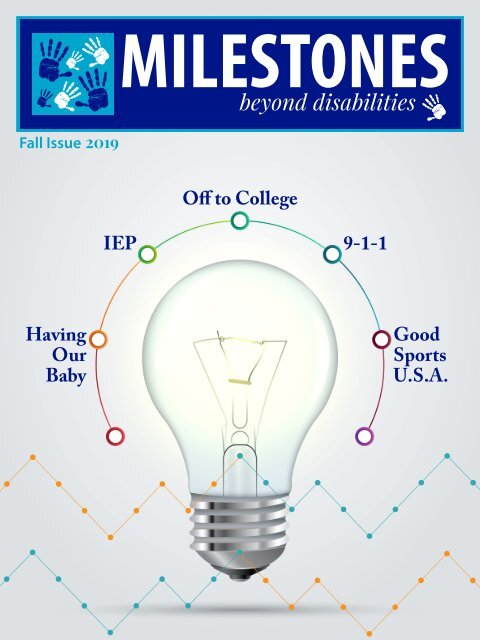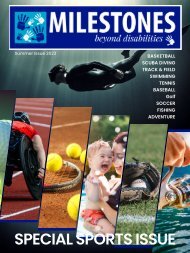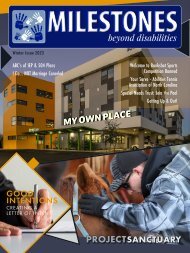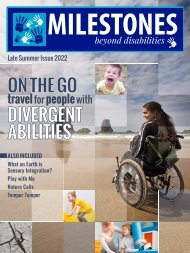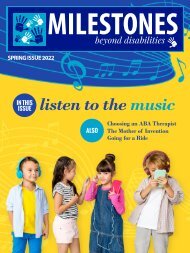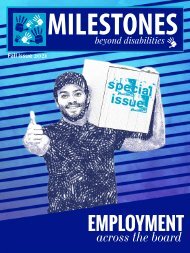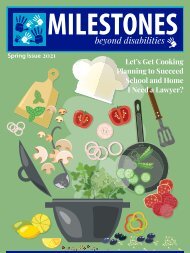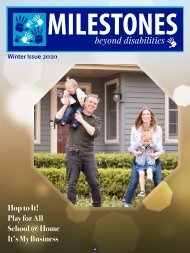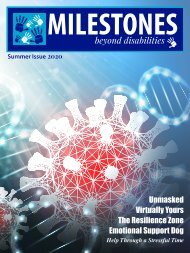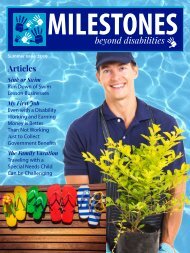Milestones Magazine Fall Issue
Milestones Magazine was developed to help individuals with disabilities and their families achieve and celebrate events and milestones in their lives.
Milestones Magazine was developed to help individuals with disabilities and their families achieve and celebrate events and milestones in their lives.
Create successful ePaper yourself
Turn your PDF publications into a flip-book with our unique Google optimized e-Paper software.
eyond disabilities<br />
<strong>Fall</strong> <strong>Issue</strong> 2019<br />
Off to College<br />
IEP<br />
9-1-1<br />
Having<br />
Our<br />
Baby<br />
Good<br />
Sports<br />
U.S.A.
nside<br />
Parent of Young Children<br />
03 Let’s Take a Walk<br />
05 Toilet Training - Woa Horsie<br />
Preschool / School Age<br />
07 IEP Ins & Outs<br />
10 Good Sports U.S.A.<br />
Teen / Young Adult<br />
11 Gateway to the Work a Day World<br />
13<br />
15<br />
19<br />
22<br />
25<br />
Off to College<br />
Customized Employment: Carving out a Job<br />
The Birth, Care, & Feeding of a Micro-Enterprise<br />
Having our Baby<br />
Guardianship or Power of Attorney: What Gives?<br />
All Ages<br />
14 Man’s (and Woman’s and Child’s) Best Friend<br />
17 9-1-1, What’s Your Emergency?<br />
1FALL 2019
Publisher<br />
Susie Redfern, is the parent of a special<br />
needs child who recently “aged out”<br />
of the public-school system.<br />
She developed <strong>Milestones</strong> <strong>Magazine</strong><br />
to help individuals with disabilities<br />
and their families achieve and celebrate<br />
events and milestones in their lives.<br />
info@milestonesmagazine.com<br />
<strong>Milestones</strong><strong>Magazine</strong>.net
LET’S<br />
TAKE<br />
a<br />
WALK<br />
For parents, the top<br />
three developmental milestones<br />
in the first years of their<br />
children’s lives are<br />
talking, walking, & toileting<br />
independently.<br />
Parents often worry whether their child is “late”<br />
developmentally and may compare their child to a relative’s<br />
or friend’s child who seemed to walk or talk practically from birth<br />
(at least according to his or her parents). Although much of this<br />
concern may turn out to be unfounded for individual children;<br />
reassurance from doctors and others that a child “will talk/walk<br />
when they are ready” isn’t always good enough either. Parents<br />
usually have a good sense of when there could be a real problem.<br />
There are things parents can do to help their child through the<br />
developmental process that leads to walking (and other gross<br />
motor activities). To outline just a few of these, I am pleased to<br />
refer to a blog by Joanne Pygon, PT, MS, PCS of Easterseals<br />
DuPage & Fox Valley, entitled “How Physical Therapy Supports<br />
Children with Down Syndrome”. Of course, the tips and<br />
techniques mentioned in this article can also help children<br />
with similar physical or coordination issues, whether or not<br />
they have Downs Syndrome.<br />
3
For infants and toddlers, physical therapists concentrate on working with the<br />
parents and child to build a foundation of strength and movement. They may<br />
use special braces for the child’s feet so his/her muscles align right. They will<br />
provide parents and caregivers with daily activities to work on with their child.<br />
They may use compression garments such as a SPIO, Benik or an abdominal<br />
binder to help with the child’s posture and allow him or her to breathe better.<br />
If the child likes water, they may suggest aquatic therapy.<br />
During the preschool years, therapy will build on what was started in<br />
infancy. Group sessions may be scheduled to develop children’s social and<br />
communication skills with peers as well. Physical therapists will check on the<br />
continued need for, and fit of, braces for children who have them. They may<br />
recommend park district programs such as swimming or gymnastics.<br />
During the elementary/high school years, emphasis is on consultation for<br />
kids involved in community-based programs. Physical therapists can help<br />
children learn to ride a bike and/or refer children to “learn to bike” programs<br />
in the community. Rock climbing may be of benefit, and Easterseals (along<br />
with park district and private organizations) offer programs at indoor facilities.<br />
Swimming lessons and group swim times are offered by many park districts<br />
and special recreation associations. For teens, all that may be necessary is<br />
updating home programs to adjust for the effects of growth on a child’s<br />
posture. Also, while a teen may no longer need braces; inserts in shoes<br />
can support their foot position and may be beneficial<br />
For the full blog, please Easter Seals DuPage & Fox Valley.<br />
For more information on Easterseals DuPage & Fox Valley Down Syndrome<br />
Services. To get started or learn more, call 630-282-2022.<br />
M<br />
4
Woa,<br />
Horsie<br />
Toilet training is a universal developmental<br />
milestone for young children, including my own<br />
children, of course. Here’s my personal take:<br />
The workshop provided parents to create make<br />
and take systems to use with their children for<br />
toilet training. Many of the attendees had children<br />
who were well beyond preschool age who still had<br />
My older son was “small for his age” when he was<br />
young. Therefore, toileting was a challenge for him<br />
with adult size toilets. We purchased a toilet seat,<br />
with the flap, that is available at most stores, and fits<br />
over the adult sized seat. My son didn’t like using it,<br />
and the very next day came up with his own<br />
solution to the problem. He marched into the<br />
significant toileting challenges. I was highly<br />
motivated for my son not to become one of these<br />
children. My take-a-way from the workshop was the<br />
emphasis the workshop operator, Patti Boheme, put<br />
on the reliance on routine that people with autism<br />
have. That reliance on routine is the primary way<br />
that many people with autism learn.<br />
bathroom, climbed up onto the toilet facing the<br />
back, straddled it, put his hands down in front of<br />
him to anchor himself, and went to the bathroom.<br />
That was the way he used the toilet from that day<br />
until he was tall enough to stand and use the toilet<br />
as most guys do.<br />
Therefore, as soon as the workshop ended, I<br />
started toilet training in earnest with my son. While<br />
I didn’t use most of the “bells and whistles” I had<br />
created, I did introduce my son to the toilet and<br />
had him use it several times daily. Although it took<br />
a year and a half for him to independently use the<br />
My younger son was a “different kettle of fish” in<br />
this area (and others) due to his developmental and<br />
bathroom; when he was ready it all happened in<br />
one day (though accidents did happen routinely<br />
for several more years).<br />
cognitive issues. At the time he was a preschooler<br />
(some 20 years ago), we had an opportunity to<br />
attend a 2-day toilet training workshop that Little<br />
Friends was offering at no charge (and they had<br />
me at free!).<br />
Although Little Friends no longer offers extensive<br />
workshops for parents, they still provide assistance<br />
to parents. I am pleased to introduce Patti Boheme<br />
of Little Friends, who offers advice and resources<br />
5
for parents to toilet train children who have<br />
it is challenging the longer you wait.<br />
challenges.<br />
Most children will become independent in toilet<br />
“Tips for Toilet Training<br />
training but some may need to be taken to the<br />
bathroom on a schedule but wear underwear. Being<br />
Start doing readiness training as young as 18<br />
time trained is still a higher level of independence.<br />
months. Readiness training means you change<br />
the child in the bathroom, have them sit on the<br />
toilet with the lid down clothes on. Eventually after<br />
they are very comfortable you can have them sit on<br />
the toilet without underwear. Use an adaptive seat<br />
where the hole is smaller if the child is small and<br />
could fall in or get off balance.<br />
It helps to chart what your child eats and when they<br />
go to the bathroom every half hour. The chart will<br />
show a pattern of urinating and bowel movements<br />
so you can set a schedule of when to take them to<br />
the bathroom. Then use powerful rewards for when<br />
they are dry and go to the bathroom in the toilet.<br />
Do not wait too long to start toilet training. Once<br />
the child has a strong habit of going in a pull up or<br />
Above all be consistent and stay positive. If your<br />
child has an accident stay calm and neutral.”<br />
diaper it is hard for them to make that switch. The<br />
longer you wait the stronger the habit is to void in<br />
the toilet. Many parents think children are not ready<br />
but waiting past 5 can make it even harder.<br />
For more information Patti Boheme and Mary<br />
Crissman have written a toilet training program that<br />
has a picture story of all the steps of toileting and a<br />
written manual for parents. The Toilet Training Kit<br />
It is never too late to start! We have trained<br />
individuals into their teens and early twenties but<br />
can be purchased from Little Friends Center for<br />
Autism at 630-305-4196. M<br />
6
I.E.P. (which stands for stands for Individualized<br />
Education Program) is likely the most used acronym for<br />
parents of the school-aged special needs population,<br />
as it is the gatekeeper to special education services in<br />
the public-school system; nobody can enter without<br />
one. It is the final step in the process of entering the<br />
special education system. With parental consent,<br />
children in possible need of special education services<br />
are first screened, then fully evaluated. Finally, an IEP<br />
is developed if/when it is determined the child is eligible<br />
for special education.<br />
For every student receiving special education services, the I.E.P.,<br />
is rewritten annually, a full re-evaluation is done every three years,<br />
and it is revised on an as-needed basis (usually at parent’s<br />
request). This document provides the road map for all the<br />
accommodations provided to the child to help him or her succeed<br />
in all aspects of school life and transition successfully to the next<br />
level of education (elementary to middle to high school). Transition<br />
to adulthood services start at age 14. The IEP determines<br />
whether a student officially graduates from high school at the end<br />
of senior year or stays in the school system through “transition”,<br />
which can continue up to the student’s 22nd birthday. It also<br />
determines whether a student receives services during<br />
the summer.<br />
Federal law relative to special education always look for children to<br />
be in the “least restrictive environment” possible, and it spells out,<br />
at a minimum:<br />
7
What setting the child will be placed in<br />
((e.g. special education school, special<br />
minutes) daily, weekly, or monthly to devote<br />
to occupational therapy.<br />
education (self-contained) classroom, or<br />
regular classroom))<br />
Once all the evaluations have been finished,<br />
a date will be set for an IEP conference. A<br />
What services/staff will be provided for<br />
the child (e.g. special ed. teacher,<br />
instructional aides, occupational, physical,<br />
speech therapists, psychologist, social worker,<br />
transportation)<br />
letter will be sent to the parent specifying the<br />
date of and reason for the conference, and<br />
who has been invited (e.g. parent, teacher,<br />
psychologist, speech therapist). The parent is<br />
asked to confirm the meeting date or request<br />
a date change. The parent has the right to<br />
Where the services will be provided<br />
(e.g. classroom, resource room,<br />
therapist’s or counselor’s office)<br />
bring others along with her to the meeting, but<br />
is asked to inform the school about how many<br />
he/she is bringing (generally one or two people<br />
only, for space reasons). Usually, a couple of<br />
What accommodations or adaptations<br />
will be made to the curriculum (e.g.,<br />
more time for child to complete assignments,<br />
weeks or so before the meeting, the parent will<br />
receive a proposed IEP to review and come<br />
prepared to discuss during the meeting.<br />
alternative teaching methods, or assistive<br />
technology)<br />
At a typical IEP meeting (at least every<br />
one I have participated in), each invited<br />
The IEP process starts when a parent requests<br />
testing of their child for possible special needs<br />
that impede his/her learning; or when school<br />
staff recommend a child for testing and the<br />
parent agrees. The classroom teacher and<br />
other school staff, as appropriate, will evaluate<br />
the child and write a report. For example, the<br />
participant goes over his or her report with<br />
the parent. The reports typically specify goals<br />
to be reached and how progress toward<br />
those goals is to be measured. At the end<br />
of the conference, the parent has the<br />
opportunity to agree with the goals as written<br />
or request changes.<br />
occupational therapist will evaluate the child’s<br />
fine motor skills (e.g. use of his/her hands for<br />
writing, drawing, etc.), recommend activities<br />
to address the child’s difficulties in that area,<br />
and suggest the amount of time (number of<br />
Most parents are involved with their children’s<br />
education and want them to be as successful<br />
and happy as possible. Children with special<br />
needs add another wrinkle to the educational<br />
8
process, and disagreements, ranging from<br />
minor to nearly needing to call out the National<br />
Guard, are common. School systems generally<br />
have procedures for parents and staff to follow<br />
when disputes happen or parents don’t feel<br />
that aspects spelled out in the IEP aren’t<br />
being implemented properly (in other words,<br />
can help remind parents about their legal<br />
rights no matter where their children ultimately<br />
end up, whether it’s the public school system,<br />
private school, or home-schooling (and homeschooled<br />
children can remain officially enrolled<br />
in a public school to receive therapy services<br />
and participate in extra-curricular activities).<br />
not meeting their child’s needs). In some<br />
cases, outside experts, in particular “IEP<br />
advocates”, are brought in by the parents.<br />
Finally, it’s important to remember that the<br />
overwhelming majority of parents and school<br />
personnel want children (including those with<br />
IEP advocates are paid or unpaid advisers/<br />
consultants. They can accompany parents<br />
to IEP meetings, review IEP documents,<br />
and guide parents through the dispute<br />
special needs) to succeed and be happy; and<br />
will work (sometimes even together), to the<br />
best of their collective abilities, to help make<br />
that happen.<br />
resolution process. They can help parents<br />
“simmer down”, pick their battles, and fight<br />
those battles effectively and hopefully, with no<br />
collateral damage to their children (or school<br />
personnel, for that matter).<br />
Acknowledgements: Thanks to contributor<br />
Stacie Green, who read the article and offered<br />
her comments. Stacie Green has been at both<br />
ends of the IEP process, as a parent and as a<br />
volunteer IEP advocate. Her email address is<br />
They are there for the parents when there are<br />
staciegrn72@gmail.com and she can be found<br />
disagreements with a school district on where<br />
and how their children are educated so they<br />
on Facebook.<br />
M<br />
can best meet their potential and thrive. They<br />
9
Good<br />
While team sports aren’t everyone’s “cup of tea”,<br />
they do appeal to a large number of people,<br />
especially families with preschool-school aged<br />
children. Park districts, special recreation<br />
association and well-known (or not so well known)<br />
private organizations provide programs for many<br />
sports, including (but not limited to) baseball,<br />
Sports<br />
U.S.A.<br />
football, soccer, tennis, and hockey.<br />
Generally, for parents, when considering a program,<br />
the first thing to determine is whether the child is<br />
interested in the particular sport in question or at<br />
least willing to give it a try. Then factor in whether a<br />
specific program has the right support, atmosphere,<br />
etc. for your specific child. Even within the same<br />
family, it is not usually “one size fits all”.<br />
Special recreation associations and some other<br />
community-based sports programs are exclusively<br />
An extra wrinkle comes into play (apology if this<br />
is a mixed metaphor) when there is a child with<br />
challenges in the family; be they visual or<br />
hearing, physical and/or coordination, language<br />
and/or speech, or cognitive and/or sensory. Those<br />
families often are looking to choose between a<br />
“regular” program that offers supports and<br />
accommodations and a program exclusively for<br />
for children with challenges or have teams or clinics/<br />
classes for them. It would be a mistake, however, for<br />
parents to automatically assume that a specialized<br />
program is right for your child. I have personally<br />
enrolled my son in a couple of special recreation<br />
programs in the past that turned out to be “over his<br />
head” and of little interest/benefit to him. Parents still<br />
need to do their homework about this.<br />
children with their child’s specific challenges.<br />
To wind this up: while I generally avoid advocacy<br />
Park districts generally offer supports and<br />
accommodations. Major sports organizations do as<br />
well (though I can’t, of course, guarantee that). What<br />
may be offered in one location or metro area may not<br />
exist elsewhere. There are also local or “mom and<br />
pop” sports programs that may include children<br />
positions; I will make an exception now. I boldly come<br />
out in favor of respect, support, and civility towards<br />
all players, spectators, coaches, and umpires/referees.<br />
Many of the latter two are volunteers and/or not much<br />
older than the players themselves. I believe that<br />
winning (as in the team that scores the most points)<br />
with challenges.<br />
is not everything; it isn’t even the only thing!<br />
M<br />
10
GATEWAY to the WORK a DAY WORLD<br />
My older son’s first job was at a seasonal pop-up toy<br />
store at a local mall. The store was called “All Wound Up”<br />
(which we privately and not so jokingly referred to as<br />
“All Screwed Up”). His second job was a summer position<br />
as help desk at a computer lab at a local college. His next<br />
gigs were at fast food joints. He eventually ended up<br />
going for a Master’s Degree, and landed a career-track<br />
civilian job at the National Security Agency (NSA) in the<br />
whose mission is to provide job training for people with<br />
disabilities. He has a weekly shift there and I am his<br />
volunteer job coach. Each family pays a monthly fee, of<br />
which roughly half comes back to the worker as minimum<br />
wage for about 10 hours of work per month. State<br />
government assistance to him to help obtain and keep<br />
a job is unavailable, as a vocational evaluation has<br />
deemed him “not work ready”.<br />
Baltimore/Washington D.C. area.<br />
For many teens and college age adults, their first job is a<br />
My younger son’s trajectory was quite different. He has<br />
autism and some cognitive impairment. While in school,<br />
he had a handful of training opportunities, mostly<br />
involving recycling at his school and other district schools<br />
to which he was transported. The vocational coordinator’s<br />
assessment of his abilities was that he can succeed at<br />
a volunteer job with maximum support. His only real<br />
milestone; providing them an income, independence, and<br />
a starting taste of adult life. For many people, there are<br />
sometimes obstacles to getting and/or keeping that job<br />
(or subsequent jobs). However, as my son’s experiences<br />
show, for people with challenges, those difficulties are<br />
often compounded, resulting in an unemployment rate<br />
that can approach 80% (or higher).<br />
work experience is as “team member” at a greenhouse<br />
11
For tips on the job search process for people with<br />
disabilities, I am pleased to introduce Giana Ferrari Ayers<br />
of Ferrari Resource Group.<br />
“Figuring out<br />
what is the<br />
“Figuring out what is the right job for someone with<br />
a disability (or even without one, for that matter) involves<br />
a variety of considerations. Personal interests,<br />
environmental preferences, academic achievement,<br />
aptitudes, temperament, strengths, and limitations all<br />
factor into the decision-making process. It is also<br />
important to consider any reasonable accommodations<br />
right job<br />
for someone<br />
that will be required to perform the job. Examples i<br />
nclude job coaching, modifications to the physical work<br />
environment, and regularly scheduled breaks.<br />
Once possible job areas or types have been identified,<br />
the next step is to locate and apply for jobs. These can<br />
be found through online search engines, job boards, job<br />
with a disability<br />
clubs, job fairs, and networking. I always encourage<br />
my clients to explore their own network of friends,<br />
family, neighbors, teachers, and other connections<br />
to identify new opportunities. Contacting local<br />
INVOLVES<br />
a variety of<br />
businesses (on the phone or in person) can also be a<br />
great way to find jobs that may not be advertised.<br />
Applying and interviewing for a job can be an<br />
overwhelming process. To stay organized, it is helpful<br />
to create a file on the computer to house contact<br />
information, a summary of past employment or volunteer<br />
considerations.”<br />
experience, and reference information. This file can be<br />
accessed for each application which will save time and<br />
frustration. Whenever possible, seek out the assistance<br />
of a vocational rehabilitation counselor to provide<br />
structure and guidance. They can also assist with<br />
interview techniques, disability disclosure (if applicable),<br />
and communicate any accommodations required.”<br />
M<br />
Giana Ferrari Ayers<br />
Ferrari Resource Group, Inc.<br />
28379 Davis Parkway Unit 801 (Clarus Center)<br />
Warrenville, IL 60555<br />
giana@ferrariresourcegroup.com<br />
630-393-0499 (Fax)<br />
gianaferrari.com<br />
12
GOING TO COLLEGE<br />
Going off to college is a milestone for many<br />
high school students, who may start their college prep<br />
as early as their freshman year of high school. They get<br />
on the “college prep” track for their coursework, take<br />
honors or advanced placement (AP) classes, do<br />
extra-curricular activities, and so on, at least in part<br />
to develop a “resume” that will look good to colleges<br />
of their choice.<br />
The college prep process can be similar for students with<br />
learning challenges, but they will typically need supports;<br />
not just for succeeding with their high school classes,<br />
but also in preparing for and succeeding in college.<br />
While supports are typically available during the high<br />
school years, particularly for students receiving special<br />
education services, those supports and services are not<br />
typically “baked into the cake” at the college level.<br />
That being said, all is not lost. Students can audit<br />
classes of interest (no-credit option) and some colleges<br />
and universities have formal programs set up that<br />
provide supports, but treat these students the same as<br />
any other college student. There are also organizations<br />
and businesses that work with students and their<br />
families to meet the challenges involved in preparing<br />
for and succeeding in college.<br />
One such organization is JJB Educational Consulting,<br />
Inc., which serves students with learning differences.<br />
They provide assistance to students with learning<br />
differences and their families. They help high school<br />
students select classes, extra-curricular activities, and<br />
summer options that meet their interests. They discuss<br />
learning support options and assess independent<br />
living skills. They assist in all aspects of the college<br />
testing, application, and selection process. They have<br />
presentations for students and families at local libraries<br />
and other locations.<br />
M<br />
Jordan Burstein<br />
JJB Educational<br />
Consultants Inc.<br />
1441 Hemlock Knoll Terrace<br />
Northbrook, IL 60062<br />
847-940-8090<br />
JJB-edconsultants.com<br />
collegesupports.com<br />
jordan@jjb-edconsultants.com<br />
13
Man’s<br />
&<br />
Woman’s<br />
&<br />
Child’s<br />
Best<br />
Friend<br />
For most families, a dog is just a pet, who provides companionship, learns<br />
tricks that the family teaches him or her, and gets taken for walks daily. It’s<br />
a different slant, however, for individuals with disabilities. For them, a dog<br />
is a trained caregiver that performs needed tasks and/or provides them the<br />
independence to achieve desired milestones in their lives.<br />
A number of organizations, mostly not-for-profit, exist throughout the<br />
United States to train these dogs and provide them to families. One such<br />
group is Canine Companions for Independence, which has a Greater<br />
Chicagoland chapter.<br />
Canine Companions is a 501(c)(3) non-profit organization that provides<br />
highly trained assistance dogs and ongoing support to ensure quality<br />
partnerships. They train dogs to help adults with physical disabilities by<br />
performing daily tasks, alert the deaf and hard of hearing to important<br />
sounds, enhance independence for children and adults with physical,<br />
cognitive and developmental disabilities, and work with professionals<br />
in a visitation, education or healthcare setting.<br />
Canine Companions for Independence can be visited at their website.<br />
The Greater Chicagoland Chapter is a local volunteer group dedicated<br />
to fund raising, spreading awareness and supporting local volunteer puppy<br />
raisers. The chapter can be visited at their Facebook page and emailed.<br />
M<br />
14
Customized employment: carving out a job<br />
Among the terms and acronyms bandied about around<br />
families who have children with disabilities, customized<br />
employment comes to or near the top of the list for some<br />
families as the child becomes a teenager and young adult.<br />
It can be an approach to finding or creating employment<br />
that focuses on folks with disabilities who have difficulties<br />
“A Carve Out is an employment<br />
opportunity; working in the community,<br />
in a position that was created with the<br />
Job Seeker’s strengths in mind.<br />
and challenges beyond the usual scope of the traditional<br />
vocational rehabilitation system. Some of these people may<br />
have a skill or talent, such as counting cards in Las Vegas (and<br />
thus saving their brother’s business) that brings in enough<br />
income that they are considered gainfully employed. Folks in<br />
this category tend to have talent in the creative or performing<br />
arts, or perhaps a focused interest in something that can be<br />
developed into a profitable business.<br />
The customized employment process focuses, first, on<br />
So, who creates these jobs? I do - as a Case Manager/Career<br />
Counselor helping adults with varying disabilities obtain and<br />
maintain employment. I believe information is power; the<br />
intent is to share my approach to creating sustainable and<br />
successful Carve Out job opportunities, with you the reader.<br />
Let’s get started!<br />
When would a Job Seeker benefit from a Carve Out?<br />
Here are a few instances:<br />
discovering the challenged individual’s likes, dislikes, skills,<br />
interests, and so on. Based on where this process leads,<br />
self-employment options may be explored, either along with<br />
or instead of community employment. Businesses that might<br />
When an individual’s maximum work hours per week are less<br />
than 10 hours (based on recommendations of their health<br />
provider to maintain physical and/or emotional stability).<br />
employ the person can be identified and the counselor, in<br />
effect, scouts them. He or she will talk to the owner or<br />
manager, employees, read job descriptions, and so on, to<br />
determine if the business’ operations can be streamlined in<br />
When individuals need long term on-site support (on the job<br />
support/Job Coaching, due to disability and level of support<br />
needed to maintain successful employment).<br />
some ways and a job “carved out” for the individual with a<br />
disability. Basically, the goal is a “win-win” situation for<br />
the business and the individual with a disability.<br />
Successful customized employment outcomes don’t just<br />
come out of thin air or through wishful thinking (much as<br />
When an individual whose work skills and strengths are<br />
specific to one area or task (this Job Seeker would likely be<br />
most successful with an accommodating employer, who can<br />
Carve Out a position, performing a single or minimum<br />
number of tasks).<br />
I’d like to believe otherwise). They depend on the individuals<br />
with disabilities themselves, their families, friends, vocational<br />
skills counselors/professionals, non-profit organizations, and<br />
companies that specialize in the field.<br />
One such professional is Jody Verble, who works as a career<br />
If it has been determined that an individual would be most<br />
successful in a Carve Out position, the first step towards<br />
this goal is to address the Job Seeker’s Stability: Medical,<br />
Psychiatric, Residential and Transportation (for more details,<br />
refer to the 4 Areas of Stability).<br />
counselor helping adults with various disabilities to maintain<br />
community employment. She will elaborate on customized<br />
employment and how individuals, families, advocates, and<br />
caregivers can participate in the process.<br />
Why is this important?<br />
If the Job Seeker is actively suffering from psychiatric and/or<br />
medical condition(s), is ‘in between residences’ or does<br />
15
Job Seekers<br />
not have a reliable way to get to/from work (i.e., is lacking<br />
Interest<br />
stability in one of the 4 Areas); short- or long-term success<br />
of employment (even a Carve Out position) will likely be<br />
negatively affected.<br />
Job Seekers<br />
Likes<br />
The next step is to identify appropriate job matches. I use<br />
a questionnaire, taking a person-centered approach, to<br />
engage the individual and gain feedback on their goals,<br />
interests and needs. Feedback is key. The initially reported<br />
Job Seekers<br />
Dislikes<br />
needs, interests, goals often change throughout the job<br />
search process. Therefore, I request feedback weekly<br />
and adjust the job search focus as needed.<br />
Job Seekers<br />
Skills<br />
As the Case Manager, I always consider the following<br />
information, when seeking a Carve Out on behalf of the<br />
Job Seeker: a job that meets their interests, strengths,<br />
work hours, transportation needs, work environment, work<br />
restrictions reported, and all other needs/preferences reported.<br />
I work with the individual’s strengths and work around<br />
potential barriers. By anticipating the Job Seeker’s individual<br />
barriers to employment, and reduce/eliminate those barriers<br />
with a plan, employment goals can be realized with more<br />
success and less frustration. This is where Preparation<br />
Meets Opportunity.<br />
How do I go about finding a Carve Out job?<br />
I have found that privately owned companies, not national/<br />
chain companies (for example), are excellent places to seek<br />
A Carve Out position is beyond a reasonable<br />
accommodation(s); it’s a request of an employer to create a<br />
position that otherwise did not exist. Once the Carve Out is<br />
secured, on the job support/Job Coaching may be of benefit<br />
to the New Employee: learning their new job task(s) and<br />
company policies, developing natural supports, communicating<br />
with co-workers and management, and the numerous<br />
other details associated with starting a new job - all in an effort<br />
to support the goal of successful community employment.<br />
Carve Out opportunities. With privately owned companies the<br />
owners and/or decision makers are more accessible to discuss<br />
their company’s needs, which then allows me to speak with<br />
the decision maker about possible Carve Out opportunities<br />
and the value the Job Seeker/candidate would bring to the<br />
team if he or she is given the chance.<br />
Why not national/chain companies?<br />
My experience has been that ‘chains’ are duplicated systems,<br />
The result:<br />
Carve Outs create employment opportunity for those<br />
individuals who require more support. Coupled with an<br />
appropriate job match, working in the community also:<br />
promotes independence, builds self-confidence, boosts<br />
self-esteem, not to mention - the increased pride and dignity<br />
that results from a hard day’s work and the purchasing power<br />
of the paycheck that follows - priceless.”<br />
often with corporately driven budgets that support those<br />
(duplicated and proven) systems, which limits that company’s<br />
local location’s management from making Carve Out<br />
opportunity decisions. Example: during a recent conversation<br />
with a Store Manager, of a national chain retail location,<br />
I asked if she had ‘stock only’ job opportunities - as the Sales<br />
Editor’s Note: The process of customized employment works<br />
differently for each individual because each person brings<br />
their individual strengths, interests, and abilities to the process.<br />
Therefore, this article, by necessity, is rather general. For more<br />
specific advice, please contact Jody directly.<br />
Associate job description for her location included ‘cross<br />
training’ and register work. The response received<br />
included the Store Manager’s frustration that all hires are<br />
required to perform register duties, due to the companies<br />
Contributor Jody Verble, a suburban Chicago resident,<br />
maintains a blog, Disability Peer Advocates, which offers<br />
tips to job seekers. She can be reached by email.<br />
M<br />
limited monthly payroll budget.<br />
16
What’s Your<br />
Emergency?<br />
Children (and adults) with developmental disabilities are<br />
not a different species from the rest of us. They act up or<br />
act out for the same reasons that we all do. Their<br />
behaviors often fall into the good (or at least tolerable),<br />
annoying, or potentially expensive (hello, clogged toilet!)<br />
categories, but don’t make them a true danger to<br />
themselves or others.<br />
That is not always the case, however. Circumstances at<br />
home or school may deteriorate and suddenly an<br />
individual is acting out in ways or to a degree that is<br />
unprecedented for him or her. That individual now<br />
poses a threat to his/her safety and the safety of anyone<br />
in range. So, what’s a parent to do? Calling the police<br />
is a frequent response.<br />
As police officers are likely to come into contact with individuals<br />
in crisis, whether in public or through a<br />
domestic disturbance call to 9-1-1, police departments<br />
throughout the United States are responding to these<br />
situations. Their priority is to keep everyone involved in<br />
a particular situation safe, including responders, the<br />
individual, his/her family, and members of the public.<br />
In Aurora IL, where I live, the police department has<br />
instituted a community policing program called “Crisis<br />
Intervention Team”. The information included here about<br />
it comes from a handout I obtained from police officer<br />
Douglas Rashkow at a recent resource fair hosted by<br />
the Indian Prairie District 204 Special Needs PTA.<br />
“The Aurora Crisis Intervention Team (CIT) program<br />
consists of officers specially trained to respond to those<br />
in crisis or with mental health emergencies, including<br />
17
people having suicidal or homicidal<br />
ideation, psychosis, or in a mental health,<br />
developmental disability, or brain disease<br />
(dementia) related emergency), to help them<br />
safely through the crisis and direct them to<br />
appropriate resources. The CIT program also<br />
is called upon for domestic disturbance or<br />
quasi-criminal related issues or crisis.<br />
Our CIT partner with local service providers<br />
and definitive care systems, State, Federal,<br />
local and privately funded, to make the best<br />
referrals and deferrals for continuing care. Our<br />
CIT respond during crisis, but also meet with<br />
families who have, or are expected to have<br />
crisis, to avoid critical incidents, and after<br />
crisis to ensure continuing safety and build<br />
relationships.<br />
The Crisis Intervention Team Program also<br />
works hand in hand with the Elder Service<br />
More Information or Enroll in S.N.A.P.P.:<br />
Aurora Police Department<br />
1200 E. Indian Trail, Aurora IL 60506<br />
630-256-5000<br />
You will complete a S.N.A.P.P. Release Form<br />
Officer Program, focusing on senior safety<br />
issues and the Special Needs Aurora Police<br />
Program (S.N.A.P.P.), for wrap around services<br />
for those with disabilities including, but not<br />
limited to, mental illness, dementia, or<br />
developmental disabilities”.<br />
M<br />
18
The<br />
Entrepreneurship (as in owning/operating a<br />
business) is a milestone/goal to which some<br />
aspire, and one to which some people with<br />
disabilities regard as preferable. Its potential<br />
Birth<br />
for income coming from something you like<br />
to do and are good at without having to be<br />
hired and fit into an established workplace<br />
can be attractive.<br />
Care<br />
As the parent of a child with a disability, this<br />
option, suggested for my son from school<br />
district transition personnel, basically<br />
amounts to “go forth and micro-enterprise”.<br />
Feeding<br />
Though I know it’s probably grammatically<br />
(though perhaps not politically) incorrect to<br />
use micro-enterprise as a verb, this may not<br />
be such bad advice, especially for the more<br />
and<br />
entrepreneurially minded among us.<br />
However, the advice did not come with<br />
any practical suggestions for starting a<br />
Maintenance<br />
micro-enterprise and making it into a<br />
of<br />
a<br />
profitable, enjoyable, and fulfilling venture<br />
for all involved. So, like the Little Red Hen,<br />
I will do that myself (but don’t expect a loaf<br />
of bread at the end of this article!).<br />
The conception and birth of a micro-enterprise<br />
can start with four one-word questions:<br />
who, what, where, and how (not necessarily<br />
in that order).<br />
Micro-enterprise<br />
19
What?<br />
What do I plan to do or make, produce,<br />
distribute, and sell?<br />
Some people base a business on a talent or skill for<br />
which they have an interest, maybe even a passion,<br />
such as painting. Others design or invent a product<br />
that solves a problem affecting them or a family member;<br />
such as an easy-fastening mechanism for people who<br />
have arthritis. Still others base a business on a service<br />
that businesses and individuals need: lawns have to be<br />
cut, papers shredded, attics cleaned, and so on. And<br />
some people and businesses don’t have the time, ability,<br />
or desire to do these things themselves, so they’re willing<br />
to “outsource” them (which is where you come in).<br />
Who?<br />
To whom do you plan to sell your product/service.<br />
Some, by their very nature, are local, so potential<br />
customers or clients are folks in your neck of the woods.<br />
Lawns cannot be exported to China. Others, with the help<br />
of computers and the internet, can be regional, national,<br />
or even global in scope.<br />
Where?<br />
Where will the product be displayed or sold?<br />
Artistic work typically shows up at art galleries, “flea<br />
market” type events and websites such as Etsy. Writers<br />
can blog. Clothing products can be sold at retail stores<br />
(usually distributed through a wholesaler).<br />
How?<br />
How will the product be displayed or sold?<br />
This question is similar to the where question, and<br />
can often produce the same answer.<br />
20
As you may have realized by now, answers to<br />
these 4 questions often overlap, and collectively can<br />
provide the underpinnings of a business plan. A<br />
business plan, whether informal or professionally<br />
done, helps you focus on the essentials of your<br />
business. It is required if you will approach a<br />
traditional loan source, such as a bank, for financing.<br />
And it may be necessary for types of creative<br />
financing, such as venture capital, whether from<br />
an established fund or through crowd-funding.<br />
The following resources are both based in the<br />
Chicago area. Life’s Plan Inc. Pooled Trust Services<br />
can help with financing for individuals who meet their<br />
criteria. Perk Center Café can serve as an example<br />
or inspiration for folks looking to start their own<br />
micro-enterprise.<br />
Life’s Plan Inc. Pooled Trust Services - website<br />
Life’s Plan Inc. Pooled Trust Services periodically<br />
offers Micro-industry grants of up to $2,000 for adults<br />
with disabilities or mental illness who meet Social<br />
Security’s disability eligibility criteria under the<br />
Supplemental Security Income. This is a one-time<br />
award for individuals or partnerships (less than 4<br />
people). Details about proposal requirements can be<br />
found at Life’s Plan’s website and questions/inquiries<br />
can be emailed to Scott Nixon.<br />
Local (Chicago Area) Micro-Enterprise<br />
The Perk Center Cafe is a not-for-profit business<br />
enterprise created through Great Potentials, Inc.<br />
and by four parents and one sibling of an<br />
individual with intellectual/developmental disabilities.<br />
It is a collaboration with the Glenview Park District,<br />
who donates the space for the Cafe. The Perk Center<br />
Cafe’s goals are four-fold: to provide employment,<br />
volunteer, and vocational training opportunities to<br />
individuals with developmental disabilities; to offer<br />
good quality food to customers; to build positive<br />
relationships in the community; and to serve as<br />
model to others who might wish to create<br />
businesses for the purpose of employment of<br />
people with disabilities. Feel free to visit the website.<br />
Contact Gail Metrick by email. M<br />
21
Having our Baby!<br />
The road to parenthood, symbolically speaking, defies basic<br />
arithmetic as the only time one plus one equals three. It is considered<br />
one of the major milestones of any given person’s adult life. While not<br />
all people choose to have children; and some have medical issues that<br />
make having a biological child risky or impossible; most everyone<br />
intent on having and/or raising a child finds a way to do so. And,<br />
generally speaking, that process moves forward for individuals and<br />
couples without interference from outsiders, other than those involved<br />
in the process of adoption.<br />
That is not always the case for adults with disabilities. <strong>Issue</strong>s for them<br />
range from having to adapt how they provide care for their child due to<br />
the disability to dealing with child welfare authorities concerned that the<br />
disability affects their fitness as parents. The first issue is easier to find<br />
solutions for; parents can get very creative about this. My mother-in-law<br />
told my husband a story about a woman she knew with no arms who<br />
gave her baby baths using her feet.<br />
22
23
For a firsthand account of parenting when you have disabilities; I am pleased<br />
to introduce Ashley Taylor and her husband, with some tips from their blog on<br />
caring for a child when you have a disability. Depending on your disability,<br />
some tips may be more applicable to your situation than others. Some of the<br />
advice, such as child-proofing, also applies to families where the parents don’t<br />
have a disability.<br />
So, without further ado, I present the following tips, excerpted from Ashley’s<br />
article “Disabled parents can prep home and life for their new arrival”.<br />
“Replace stairs with a ramp. Navigating stairs while carrying a baby can pose<br />
a risk of tripping. Steps-free entrances and pathways are especially important<br />
for individuals with mobility disability as they make it easy maneuver within<br />
the home to effectively cater to the baby’s needs.<br />
Expand your corridors and doorways. Wide doorways offer enough clearance<br />
for people using wheelchairs and walkers to safely get through entrances.<br />
Install non-skid flooring. Skid-resistant flooring is vital for both parents with<br />
disabilities as well as their developing children. As your child learns to crawl<br />
and walk, they will need a safe space to practice on. Consider installing vinyl,<br />
linoleum or heavy-duty plastic mats. If you decide to carpet, ensure that the<br />
carpet is fastened on the floor and it has an even texture.<br />
Child-proof your home. For instance, install smoke detectors, carbon<br />
monoxide detectors, corner guards on the sharp corner guards of the furniture,<br />
install outlet covers and keep away hazardous items out of your child’s reach.<br />
Depending on your type of disability, you will need specialized baby care<br />
products and equipment. For instance, if you are a parent with a mobility<br />
disability, the regular baby carrier may not work well for you. If you are using<br />
a wheelchair, you may use a lap baby to hold your infant in front of you.<br />
Similarly, a parent with a hearing disability may need to invest in a babble<br />
band in place of a baby monitor. There are great baby care products for parents<br />
with disabilities. There are also numerous resources both online and offline<br />
that you can leverage for support in your parenting with disability journey.<br />
These include both governmental and non-governmental agencies, websites<br />
and community-based support groups.<br />
While being a parent with disabilities presents unique challenges, with the<br />
right information, resources, planning and preparation, it can be a journey<br />
full of joy and satisfaction. Take time to prepare your home, get baby care<br />
products that are appropriate for your type of disability and identify support<br />
systems and resources. Most importantly, take care of yourself so you can<br />
be able to take care of your child.”<br />
Ashley Taylor and her husband both have disabilities. Ashley blogs, which<br />
provides advice and resources for parents with disabilities. She can be reached<br />
through a contact form at the blog or by email.<br />
M<br />
24
Guardianship or<br />
Power of Attorney:<br />
What Gives?<br />
There is much confusion and controversy among parents<br />
of young adults with disabilities, particularly those with<br />
intellectual impairments, on how best to protect their physical<br />
and financial well-being; both when the parent(s) are alive and<br />
after they are gone. Some of these parents may also be children<br />
of elderly parents with physical or cognitive issues of their own.<br />
Guardianship<br />
• A judicial decision made when an individual has not<br />
designated a POA.<br />
• It is a request by someone other than the individual it is for.<br />
• Can be of the Person or of the Estate.<br />
• Can be Temporary, Limited or Plenary.<br />
• Is only revocable when an individual can produce proof that<br />
I have experienced those issues personally, and have gone<br />
the route of full guardianship for our son. However, we have<br />
an uncomplicated set of circumstances in which nobody<br />
contested the guardianship and there’s no money (assets)<br />
involved. For many families, this matter is anything but<br />
they have regained capacity.<br />
• The Mental Health Directive is included in the Guardianship.<br />
• It is a judicial order.<br />
• Judicial oversight and guidelines for Guardianship.<br />
• Expensive.<br />
“cut and dry”.<br />
It is always better to be proactive than reactive. Planning for<br />
I am pleased to introduce the organization “Living Life with<br />
Dignity” and present portions of their article, posted online on<br />
December 7, 2017, to address the difference between Power of<br />
Attorney (POA) and Guardianship, and outline the types, and<br />
pros/cons of each.<br />
your future needs can keep you independent longer and be more<br />
cost effective. If you put a Power of Attorney in place with<br />
someone you trust and you provide them with a detailed account<br />
of what you want (or don’t want), you are more likely to be<br />
cared for the way that you want and your money will go further.<br />
“Power of Attorney (POA)<br />
• A proactive decision made by an individual when they<br />
are of sound mind.<br />
• A designation of someone known and trusted to carry<br />
directives.<br />
• Can be for Healthcare or of the Property.<br />
• Two types of POA: one that is effective immediately and<br />
the other that requires proof of capacity.<br />
• A Power of Attorney for healthcare can be revoked at any time.<br />
• A Mental Health Directive is separate from the Power of<br />
Attorney and is needed in cases where the health issue is<br />
behavioral vs. clinical (IE: Bi-polar disorder).<br />
If you don’t have a Power of Attorney or a Mental Health<br />
Directive and you become incapacitated then anyone who has<br />
a vested interest in your welfare, whether family or friend, can<br />
petition the court for Guardianship. This gives you less choice<br />
of care givers and puts you at higher risk of not having your<br />
choices honored, potentially jeopardizing your independence<br />
and financial well-being. In many cases, when someone<br />
gets Guardianship, the wishes of the individual cannot be<br />
determined, and the ward is subject to what the guardian feels<br />
is in the individual’s best interest. Guardianship proceedings<br />
in themselves can be very costly. A contested Guardianship is<br />
even more costly.<br />
• Is not a judicial order.<br />
• No oversight for a Power of Attorney.<br />
• Cost effective.<br />
When referring to Power of Attorney for the Person or of<br />
the Property vs the different types of Guardianship, you are<br />
basically referring to managing an individual personally and<br />
financially. So, let’s look at the differences:<br />
25
Difference between Power of Attorney for Healthcare and<br />
Plenary, Limited & Temporary Guardianship<br />
In a POA for Healthcare your designee can make any decision for you without<br />
a court order. Once an individual has been declared by a physician to lack<br />
competency you simply have to present your Power of Attorney paperwork.<br />
However, with a Guardianship you have to follow the court order. Both types of<br />
Guardianship give certain or all power to act on the individual’s behalf; however,<br />
anything outside of the court order has to be approved by the court. For instance: if<br />
someone has a stroke, becomes dependent on life support and it is not in the court<br />
order, it is always a best practice to go to court to make the decision whether to end<br />
life or not. This protects the Guardian as well as the Ward. In addition, the Guardian<br />
of the Person has to file an annual report with the court as a status update affirming<br />
continuation of the Guardianship.<br />
Difference between Power of Attorney for Property<br />
and Guardian of the Estate<br />
It is a known fact that our ability to reason becomes compromised as we get older.<br />
In fact, studies suggest in some people it can be as early as 65. Having someone<br />
you trust to manage your financial affairs can prevent you from being exploited,<br />
provided the person you choose is of sound integrity. Sadly, I have seen many cases<br />
where individuals have been exploited by the Power of Attorney. Transparency and<br />
proper accounting are two ways a POA can avoid these issues. I recommend when<br />
choosing the POA for property, to pick someone that is good with their own finances<br />
if you want to ensure the safety of your financial future. See This Job Sucks!<br />
Choosing the right Power of Attorney is imperative.<br />
A Guardian of the Estate has little room to exploit anyone<br />
They have to account for every penny that is spent of your money. The court<br />
requires the Guardian of the Estate to produce a yearly report and to provide the<br />
court with an annual budget. The court will readily pick a family member or close<br />
friend over a Corporate or Public Guardian. It is standard practice for family<br />
members to contribute to the welfare of their loved one, while a Corporate Guardian<br />
or the Public Guardian charge for their services. For this reason, when the court<br />
determines someone is not of sound mind, the court will default for family or a<br />
loved one to be the Guardian if appropriate.<br />
Mental Health Directive<br />
The state of Illinois requires a Mental Health Directive in addition to a Power of<br />
Attorney for Healthcare for treatment of a Mental Health Disorder. I won’t go into<br />
the why’s or the politics around it, that is fodder for another blog (next month).<br />
Nonetheless, please note that if you are preparing your estate, this should be a<br />
consideration when putting your directives in order, regardless of whether you suffer<br />
from a mental illness or not. See What is a Health Directive for Dementia?<br />
Your Power of Attorney should know where you keep all of your important<br />
documents, and above all, be transparent. This way, if ever anyone wanted to<br />
challenge your POA’s intentions or abilities, you have everything documented.<br />
NOTE: POAs for Healthcare can easily be revoked, however, Power of Attorney<br />
for Property cannot.<br />
Guardians are mandated to do all of the things a Power of Attorney does and are<br />
appointed by and accountable to the court. A physician’s report as to whether or not<br />
the individual is capable of making their own decisions is a requirement of a petition<br />
for Guardianship but ultimately the court, not the medical professional, makes the<br />
determination and the designation.” M<br />
Living Life with Dignity<br />
333 N. Randall Rd., Ste. 106<br />
St. Charles, IL 60174<br />
630-549-0654<br />
www.lifewithdignity.net<br />
info@lifewithdignity.net<br />
26
Connections child care<br />
Child Care Connections links families to child<br />
care suited to children with challenges.<br />
Child Care Connections also provides informational<br />
articles (referencing North Carolina University<br />
Extension Service) about adapting child care<br />
Features a registry that both parents and<br />
providers can sign-up for when they are looking<br />
for, or offering, care for children with various<br />
challenges, such as developmental disability,<br />
programs to children with special needs. Once<br />
you sign-up you’ll receive the article Adapting<br />
the Child Care Environment for Children with<br />
Special Needs.<br />
autism, hearing impairment, vision impairment,<br />
and more!<br />
Check out our website: milestonesmagazine.net<br />
27


